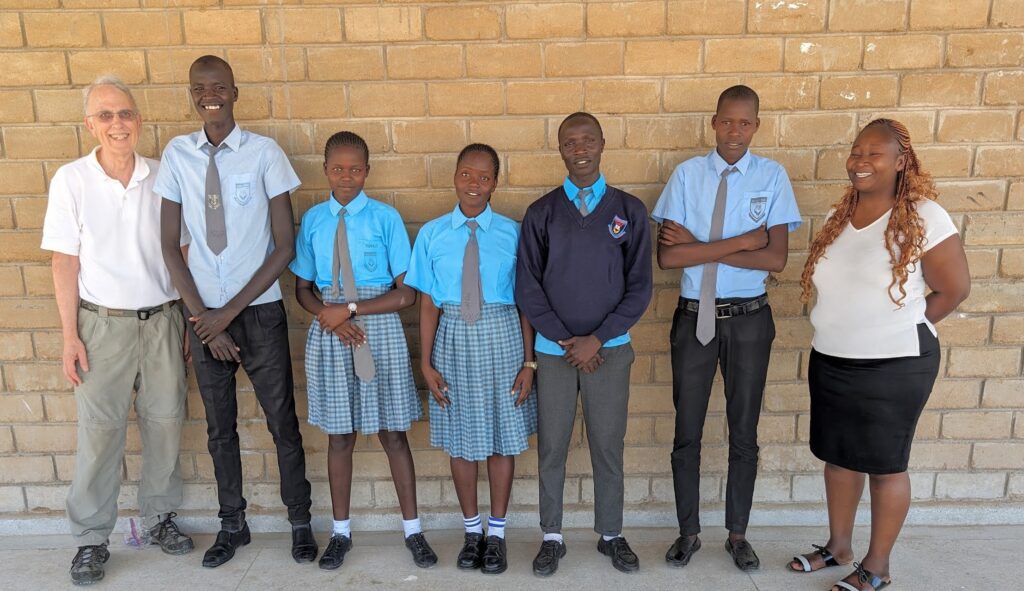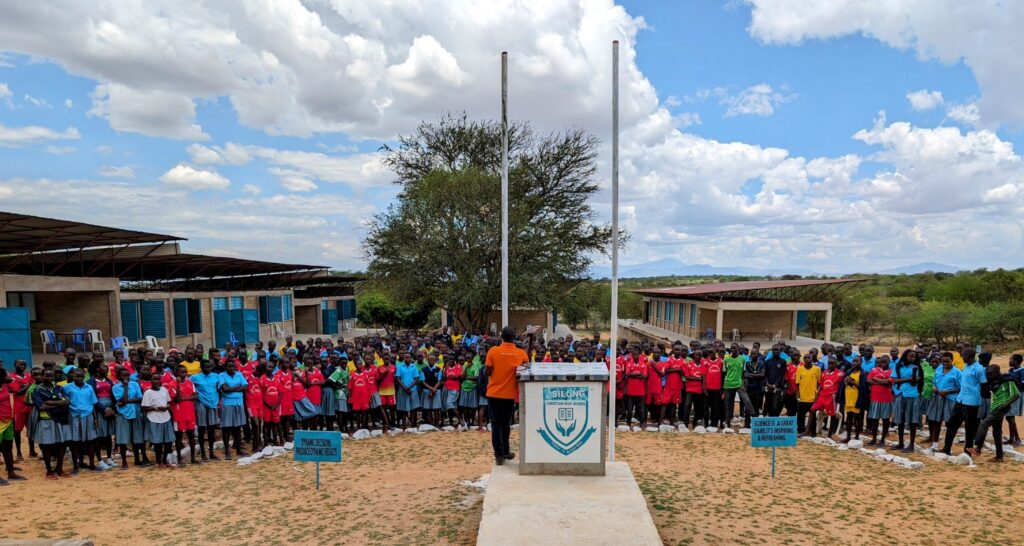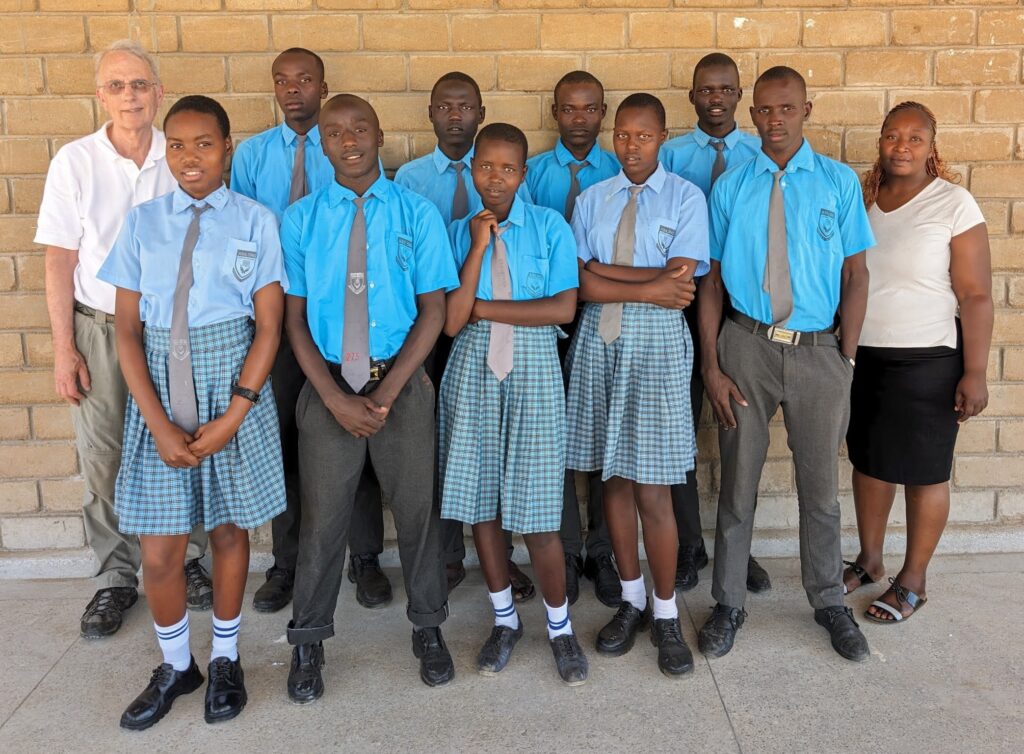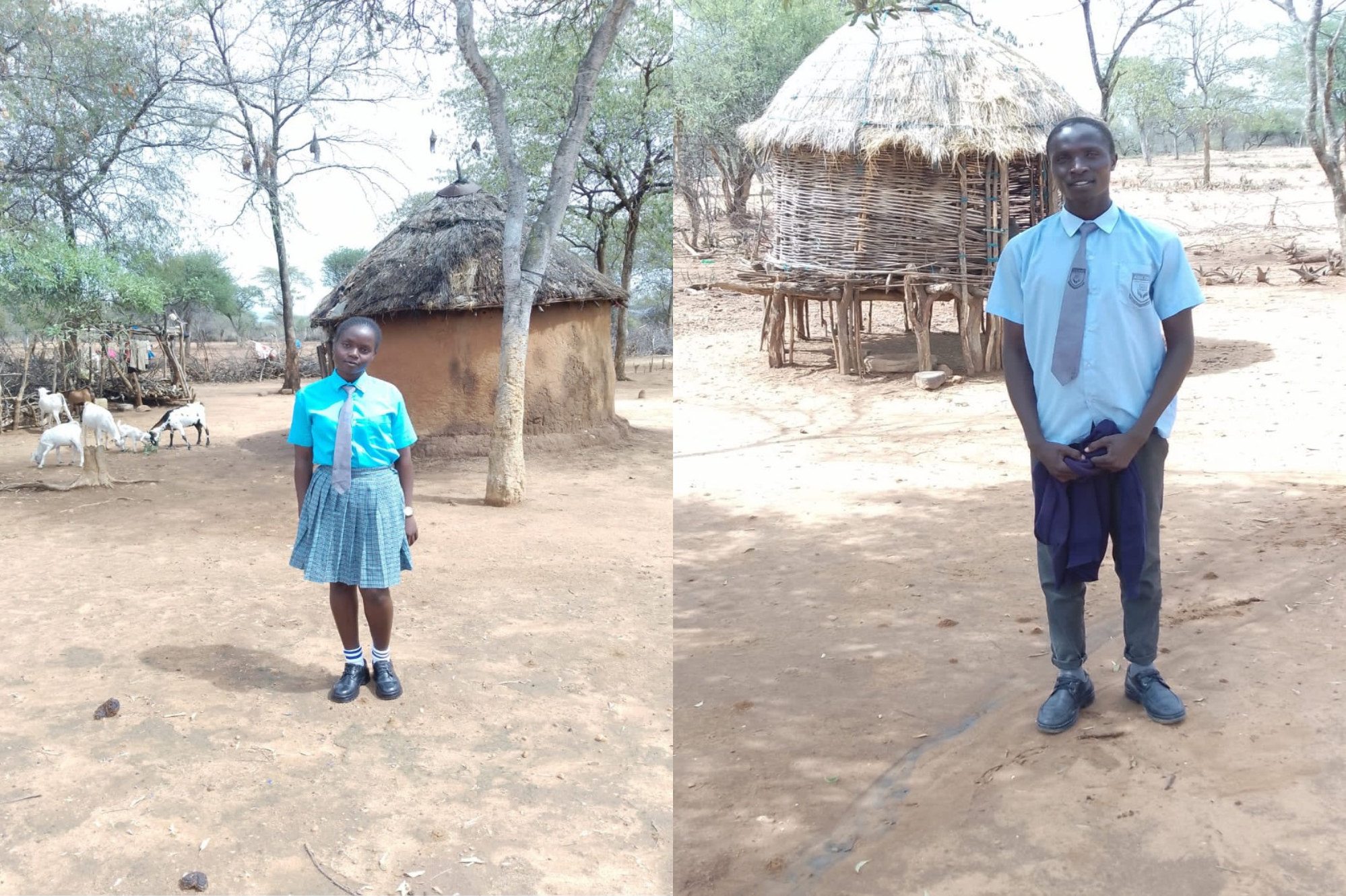Bringing the Joy of Coding to Asilong, Kenya

Gathered in a solar-powered computer lab in the remote village of Asilong, Kenya, five eleventh graders programmed in Python, coded Snapchat filters, and learned about machine learning—all from a professor on the other side of the world.
The students learned these skills through a global collaboration between teacher Juliet Rabach in Asilong, U-M Electrical and Computer Engineering (ECE) Prof. Raj Rao Nadakuditi, ECE alum Dale DeJager (BS EE 1973), and colleague Andy DuPont. The course, Joy of Coding, was designed by Nadakuditi to introduce high school students to the world of coding and its uses. The online format was designed with rural and underserved student communities in mind, launching inclusive coding education in locations where it was previously inaccessible.
While the high school in Asilong offers other computer classes that touch on programming, the existing curriculum is basic and surface level. “When you look at the Joy of Coding classes,” Rabach explained, “the coding goes deeper and actually helps the students to understand more about programming.”
Over the past decade, an increasing number of students have pursued formalized secondary education in Asilong, as its community of traditionally-nomadic Pokot people settles on homesteads centered around water wells and agricultural resources. Due to climate-change-induced drought and land politics, the Pokot have experienced increasing challenges of a nomadic lifestyle and limited access to food and water. Rather than following the traditional profession of livestock herding, students have turned to the financial promise of career paths like medicine, business, and computer studies.
DuPont began his work in Asilong in 2009, improving its clean water infrastructure and teaching at the local primary school. He then helped build Asilong Christian High School (ACHS) from the ground up, to meet the growing demand for high school education.
“The village said, ‘We have no high school. Any students who graduate primary school are having to leave,’” DuPont recalled, “And this is the first generation in the village to be formally educated.”
The first students started at ACHS in 2017, learning and living at the school as it was constructed. Since then, four classes of students have graduated with their diplomas—and 100% of graduates qualified through the Kenyan national exams to go on to college or university, compared to about 45% of students nationally.
When you look at the Joy of Coding classes, the coding goes deeper and actually helps the students to understand more about programming.
Juliet Rabach, ACHS Teacher
DuPont and DeJager met in Glen Lake, Michigan, where they both retired after working as engineers at Dow Chemical and AT&T Bell Labs, respectively. Having been involved in the Asilong community for years, DuPont asked DeJager to accompany him on a 2019 visit. On this trip, they built the ACHS computer lab, complete with 20 solar-powered desktop computers. DeJager also installed a local wireless network, using skills he developed while managing his own wireless business in the early 2000s. He and DuPont then helped the school hire Rabach, whose skill and knowledge greatly surpassed that of the other candidates.
Rabach earned her bachelor’s degree in Information Technology (IT) in Nairobi, before moving back to her hometown of Kitale, where she worked in IT prior to being hired at ACHS. She moved to Asilong in 2023 to teach the students about computers, initially unaware of the Joy of Coding class.
DeJager learned about the course from the Inside ECE magazine and thought it could be a good opportunity for the students in Kenya to expand their coding knowledge. He pitched an Asilong-based Joy of Coding cohort to Nadakuditi and Rabach, who both agreed to give it a try.
“When I came to know about the Joy of Coding, I gained a lot of interest because coding is really part of IT,” Rabach said, “Without coding, there are so many things that you can’t understand.”
Together, Rabach, DeJager, and DuPont selected a pilot cohort of five outstanding students to take the class in 2023.
Trials and triumphs of being first

Joy of Coding was a hit with the students, who worked hard to complete the coursework even with the unforeseen challenges of running a course in a new location.
“I learned many, many things that I didn’t know,” said Paul Lokapel. “The class also helped me to make my other classes easy and—even if I wasn’t doing computer classes—I could apply the learnings to my normal life.”
But, he said, “There were some struggles that made it a difficult class. For instance, when we go home for holidays, there’s no computer, phone, or email, so that interrupts the class.”
ACHS had a holiday break scheduled three weeks into the course, and, because they were part of a global cohort including students in the United States, they fell behind in the lessons during their time away. Many of the students also encountered a steep learning curve from the challenge of mastering English in addition to the coding curriculum.
This course enables someone to think critically, and your career may depend on the certificates that you get from the courses that you’ve taken.
Emmanuel Akori, ACHS Joy of Coding student
Students at ACHS live in dormitories on the 17-acre school campus, where they start their day at 5 AM and end it at 10 PM, after a packed schedule of classes, meals, and sports. Participants in the Joy of Coding course carved out an additional 4–6 hours per week to complete the course material. Rabach joined them during these hours to answer questions, provide guidance, and offer encouragement.
Despite these unique challenges, the students overwhelmingly echoed Lokapel’s positive feedback about the course. “When working on the Joy of Coding, we learned something that is helpful to our lives, and also we enjoyed it,” said Dorcas Chebet.
“When we started the pilot, we were optimistic and curious how students would react to the reading-heavy format for learning, in American English, coupled with the experiential part that required coding by doing.” Nadakuditi said, “But the course ignited their own desire to learn even more.”
“This course enables someone to think critically,” noted Emmanuel Akori, “And your career may depend on the certificates that you get from the courses that you’ve taken.”
In Kenya, students must declare a specialty during the national examination that determines whether they will qualify for college or university. Many of the students emphasized that they would continue taking computer classes and pursue a career in computing—following in Rabach’s footsteps.
Building community through education

One important mission of ACHS is to offer accessible, long-term education to the community of Asilong. Their hope is that the 380 current students will become farmers, teachers, doctors, computer engineers, and more—and that they will stay in Asilong to help it grow and thrive in the future, across many generations.
“The school receives a little bit of subsidy for operations from the US team at Friends of Asilong, but about 80% of the funds to operate the school this year are raised locally,” DeJager explained, “And our goal is to get that to 100% because we want it to be self-sustainable, not dependent on others.”
Running Joy of Coding in Asilong gave me a sense that… increasing access and explicitly teaching self-directed learning skills are the key to realizing the dream of having way more people, in every part of the country and the world, do and learn way more.
Raj Nadakuditi, creator of Joy of Coding
As part of the same set of efforts to keep Asliong self-sufficient, DuPont trained a team of local Pokot warriors to maintain and repair the water wells, and the students at ACHS are growing crops and raising chickens as a sustainable food source.
Now, a community is blossoming through Joy of Coding, as the students learn from each other and share their newfound proficiencies with peers outside of the class. “Although each student fills out the exercises on their own, they’ll find a time when they can all sit down together and work through the problems together,” DeJager observed, “There are different students who understand different aspects of the material and they’re able to help one another.”
Nadakuditi, who had not previously led an organized international cohort in Joy of Coding, was encouraged by the students’ motivation to collaborate. “It was amazing to see how easily the students took to the coursework and how they self-organized into study groups to learn from each other and accomplish way more.”
The students’ experiences in the Joy of Coding class also allowed them to help their peers with the basic computer curriculum. They enjoyed teaching and encouraging their friends, without pressure from their teachers.
“I would like to know more so that I can be able to teach other students when I finish my course,” said Panina Chemtai.
“I also teach my friends what I learned from the course,” added Lokapel, “And my friends became happy because they enjoyed that. They like the course and they said that they wish to join it in the future.”
Joy of Coding continues in Asilong

The Joy of Coding course has continued with a second group of nine students, still interfacing with Rabach and the remote material. Some students from the first cohort have taken an interest in tutoring for the course, to gain a higher level of mastery and help the incoming students work through the activities.
“Running Joy of Coding in Asilong gave me a sense that the format could work everywhere and that increasing access and explicitly teaching self-directed learning skills are the key to realizing the (as yet, unfulfilled) dream of having way more people, in every part of the country and the world, do and learn way more,” said Nadakuditi.
Nadakuditi credits EECS alum Travis DePrato (BSE CS 2019) for his critical role in building and maintaining the cloud-based interactive textbook platform that facilitates the course and its experiential learning component. He also notes that David Reeping, former postdoctoral researcher in EECS Prof. Cindy Finelli’s group, was instrumental in crafting the self-directed learning strategies that allowed the students to gain confidence through the course. Reeping, now an associate professor in Engineering and Computing Education at the University of Cincinnati, highlighted for Nadakuditi the value and necessity of teaching self-reflection alongside the technical coding skills.
In the meantime, student interest in the course continues to grow. “Maybe we’ll have more next year—we have computer facilities that could easily handle 20 students,” DeJager said.
DeJager and DuPont both stay involved with the Asilong community, visiting when they can and helping the local teachers improve the educational programming at ACHS.
 MENU
MENU 


